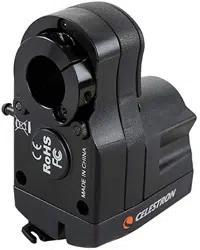Loading ...
Loading ...
Loading ...

FOCUS MOTOR FOR SCT & EDGEHD INSTRUCTION MANUAL
4 I ENGLISH
CALIBRATING THE FOCUS MOTOR
USING THE FOCUS MOTOR
Before using it for the first time, we recommend
calibrating the focus motor to indicate where the
inward and outward limits of mechanical focuser travel
for the telescope are. This will prevent the motor from
reaching the focuser limits and straining the motor.
Calibrating the focuser also sets the focuser index
positions so that accurate “Move To” commands
can be executed. The focus motor only needs to be
calibrated during the initial setup or if it is removed
and reinstalled on the optical tube. After calibration,
the focuser limits and index positions are stored in the
focus motor.
To calibrate using a Celestron hand control, press the
MENU button, then select “Focuser,” then “Calibration.”
If using either the Celestron Focuser Utility Program
or Celestron PWI software, calibration can be done
directly from the program’s user interface.
If using an ASCOM driver along with third-party
focuser control software, you can calibrate with
the driver. Select “ASCOM focuser” as the focuser,
then for Focuser Settings select “Celestron USB
Focuser.” The calibration routine can then be accessed
from the “Properties” button within the ASCOM
Focuser Chooser.
There are two ways to control the focus motor: the
motor can be manually slewed to change focus or
it can automatically slew to a specific focuser index
position.
If using a Celestron hand control, you can manually
slew the focuser by pressing the MENU button, then
selecting “Focuser”, then “Move In/Out”. You will then
be prompted to select a motor speed rate, from 1
(slowest) to 3 (fastest). The rates correspond to the
following knob rotation rates:
RATE 1: 8°/sec
RATE 2: 32°/sec
RATE 3: 128°/sec
Then, use the SCROLL DOWN and SCROLL UP
buttons to rotate the focus knob. Specifically, the
SCROLL DOWN button will rotate the focus knob
clockwise, which moves the primary mirror inwards (i.e.
towards the rear cell), and the SCROLL UP button will
rotate the focus knob counter-clockwise, which moves
the primary mirror outwards (i.e. towards the Schmidt
corrector).
The focus motor can be calibrated using any of the above
methods and will not need to be done again if changing
how the focus motor is controlled. For example, you can
calibrate with a Celestron hand control and then use
third-party software without needing to calibrate again.
When initiated, the calibration routine will slew to
the inward focuser travel limit, then to the outward
travel limit. This process takes several minutes. When
completed, the full range of travel will be indexed
from zero (the inward limit) to 1000x the number of turns
of the focuser knob needed to reach the outward limit.
So, for example, if the focuser knob has a total of 40
turns of travel, the focuser positions will be indexed from
0 to 40,000.
Loading ...
Loading ...
Loading ...
